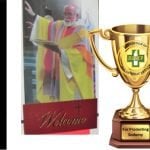
The Association of United States Catholic Priests (AUSCP) held its annual assembly in Baltimore from June 20-23. The theme of the Assembly was “LET US DREAM: The Path to a Better Future.” During the assembly, we published a report detailing the pro-homosexual ideologies of the majority of the speakers at the Conference, such as Bishop John Stowe, Fr. Danial Horan, and Sr. Mary Novak, the new executive Director of NETWORK. We also profiled the radical homosexual activism engaged in by two of their “John XXIII Award” recipients. And since 2015, the Lepanto Institute has investigated and revealed the consistent attitudes of the AUSCP that violate Catholic moral and theological teachings, such as:
- Promoting Ordained Women and Priestless Parishes
- Making Arguments for Women’s Ordination to the Priesthood
- Forcing Catholic Adoption Agencies to Provide Children to Homosexual and Transgender Couples
- Giving Venue to Condemned LGBT Organizations
- Being a Member of an International Network of Heretical Organizations
Over the years, the AUSCP has received support and benefit from the participation of cardinals, archbishops and bishops who have attended, spoken at, and celebrated Mass for the AUSCP. Such include Cardinal Wilton Gregory, Cardinal Blasé Cupich, Archbishop John Hartmeyer, Archbishop Robert Carlson, Archbishop John Wester, Bishop Richard Pates, Bishop John Stowe, and others. Abp. Wester actually serves as the official “episcopal moderator to the United States Conference of Catholic Bishops (USCCB).”
For the first time in the 11-year history of the AUSCP, an office of the USCCB apparently paid for a vendor’s table at the AUSCP’s annual assembly, meaning that money collected by the Catholic Bishops of the United States could have formally supported this morally and theologically degenerate organization.
On page 40 of the AUSCP’s 2022 Assembly Program Book, listed just above the pro-same-sex “marriage” organization New Ways Ministry, is the USCCB Office of Certification for Ecclesial Ministry.

The Lepanto Institute was able to obtain a photo of the USCCB’s booth at the Assembly, as well as one of the business cards sitting on the table belonging to Marc J. Delmonico, Assistant Director for the Certification of Ecclesial Ministry.


According to the USCCB’s website for the Office of Certification for Ecclesial Ministry:
We resource bishops, regional and state conferences of bishops, diocesan programs, and professional ministry associations and organizations across the country. We support their efforts to train those who minister in the name of the Church.
- We review and approve certification standards, competencies, and procedures, primarily for specialized ministry leadership roles in the Church for lay ecclesial ministers, but also for some priests and deacons.
- We promote these standards and other ministry formation resources, so that bishops, diocesan programs, and organizations we work with are aware of them, use them, and also promote them.
- We consult on best practice resources and the promotion of lay ecclesial ministry formation and certification, especially with diocesan and academic programs which provide comprehensive ministry formation.
Dr. DelMonico didn’t just happen to show up to the AUSCP’s assembly. It turns out, he’s an actual member of the AUSCP. In 2020, Delmonico wrote the following on his own website, under the headline “Association of U.S. Catholic Priests (AUSCP) Virtual National Conference 2020”:
“I am participating in this virtual gathering of the largest association of U.S. Catholic priests as an associate (non-clergy) member of the AUSCP. Their annual event is focused on the theme of “Our Catholic Faith in the Political World.” Opportunities for an online retreat and keynotes on church teaching in the context of legislative advocacy, preaching to the political needs of today’s society, practical action during the 2020 election year, and more. Very modest and daily or all-inclusive rates are available and anyone can register for the event. The AUSCP is an organization which is deeply committed to collaborative ministry with lay ecclesial ministry leaders and other lay ministers in today’s church. Read more and register here.”
In January of 2021, the AUSCP hosted DelMonico as a speaker for a webinar with the title, “God’s Own Vintage: Developments in Lay Ecclesial Ministry 15 Years after Co-Workers in the Vineyard of the Lord.”

It remains to be seen why DelMonico is involved with the AUSCP or why this particular office of the USCCB would purchase table space at the Assembly, but his presence is deeply concerning. One possibility has to do with the AUSCP’s promotion of “priestless parishes,” where pastoral duties would be handed off to lay ministers. The idea is that because of the priest shortage, “lay ministers” could be used to run individual parishes while priests are given the responsibility of multiple parishes, to which they travel from week to week. The AUSCP’s 2018 document, “Pastoral Care in and Through Priestless Parishes,” says at the top of page 2 that Pastoral Leaders will:
“take responsibility for the day to day coordination of parish activities, and take initiative as needed to motivate, to correct, and to affirm persons who work in the parish ministries; and where needed, provide conflict resolution and reconciliation. To be a true pastoral leader he/she must lead worship where appropriate, and likewise break open the Word. In short, he/she would be in the role of pastor, excepting sacramental ministry, and under the supervision of the canonical pastor.”
The key take-away from this is that the person the AUSCP proposes would be a pastor in all manners except for the provision of the Sacraments. But further down the page, the AUSCP suggests that this model could shape the future of the priesthood, and it specifically includes women in that assessment:
“These Lay Pastoral Leaders will provide a very important proving ground for the USA Church because we would learn what men and women, married and unmarried, can accomplish as pastoral leaders, and what kind of persons we need. We will gain a great deal of wisdom about what works and what doesn’t work. In a larger framework, it would show how the priesthood of the future might discern proven individuals.”
The last line in that quoted section, “it would show how the priesthood of the future might discern proven individuals” is the key to understand the true goal: if lay women are allowed to lead parishes as “Pastoral Leaders,” and if women can be ordained as “deacons,” then a path to discerning the “priesthood of the future” could include them as “proven individuals.”
The references section at the end of the paper lists the USCCB’s document, published by DelMonico’s subcommittee, “Co-Workers in the Vineyard of the Lord.”

Bear in mind that the title of DelMonico’s workshop for the USCCB last January included this: “Developments in Lay Ecclesial Ministry 15 Years after Co-Workers in the Vineyard of the Lord.” This connection between the USCCB’s paper “Co-Workers in the Vinyard of the Lord,” the AUSCP paper on “priestless parishes” heavy citing of the USCCB document, and DelMonico’s presentation on it to the AUSCP cannot be a mere coincidence. In the USCCB’s 70-page document, the phrase “lay ecclesial minister” appears 155 times and is defined this way on page 12:
“The term “lay ecclesial minister” is generic. It is meant to encompass and describe several possible roles. In parish life—to cite only one sphere of involvement—the pastoral associate, parish catechetical leader, youth ministry leader, school principal, and director of liturgy or pastoral music are examples of such roles. Participation in the exercise of the pastoral care of a parish, as described in the Code of Canon Law, canon 517 §2,12 is another example of lay ecclesial ministry, although it differs in kind from the other roles because it exists simply because of the shortage of priests.”
The AUSCP’s notion of priestless parishes is entirely predicated on the notion of a priest shortage, and it proposes that laypersons could step into the role of a pastor, leading parishes in “Eucharistic Services” – not as a Mass, but as a pseudo-replacement for Mass – while a traveling priest would consecrate a large number of hosts that would sustain the parish until he comes back. And the thing is, if this proposal of the AUSCP’s is accepted, it is the USCCB’s office of Certification for Ecclesial Ministry that would provide the certifications for such ministers. Of course, for the AUSCP, when this is combined with the potential to “ordain” women to the diaconate, this is one step closer for what the AUSCP said “would show how the priesthood of the future might discern proven individuals.”
One of the documents circulated at this year’s AUSCP Assembly is titled, “AUSCP Background Document to a Request to the United States Conference of Catholic Bishops Urging Full Restoration and Implementation of the Rite of Penance.” (you can see the full document here) The document was originally published on January 15, 2015 “by decision of the leadership group/board of directors,” and calls for “full implementation of the Rite of Penance, including Rite 3, the fully communal celebration with communal confession and absolution.”
Briefly, there are two rites for the Sacrament of Penance, and an emergency use sometimes referred to as the “third rite,” and more appropriately called “General Absolution.” The first is simply one-on-one, where a single penitent meets with the priest to confess his or her sins and receive absolution from the priest. The second is a community reflection with communal prayer, spiritual reading, and sometimes song, ending in individual confession as with the first rite. The third rite pertains to a grave emergency, where there is no time for individual confessions, such as being in the midst of a war zone or on a doomed transport vessel like an airplane or ship.
The AUSCP’s paper requesting the use of “rite 3” of the Sacrament of Penance complains that with Rite 1 “there would not be enough confessors if people were coming to celebrate Rite 1 in the numbers that came for private confession in the 1950s.” It also complains that “When Rite 2 is celebrated it is generally impossible to gather enough confessors to hear individual confessions properly within an appropriate period of time, not with the personal dialogue the Rite of Penance envisions and the time limits people expect.” So, because these priests do not wish to spend long times in the confessional, they pad their argument in favor of “rite 3” by arguing that it “enables penitents to experience reconciliation in and with the community as indication of their reconciliation with the Church and God.”
In short, they want confessions to be a community event, where congregants gather and assist each other in examining their consciences, and then publicly proclaim their confessions, while the priest then grants a general absolution to all present.
While not indicated in this paper, the application of this particular form of “confession” would be advantageous to their proposal for “priestless parishes.” If a priest is not regularly at one parish, and since he would not have the time to hear the confessions of all congregants in one weekend sitting, the community aspect of hearing one loud confession while granting one general absolution to all present would save time. At least, so the thinking appears to be.
Whatever the case, the development of a relationship between a USCCB office and the AUSCP is deeply distressing. The fact that a USCCB office paid for a vending table at the AUSCP’s annual assembly is bad enough – Catholic funds were sent to this association of dissident priests. Worse is that the associate director of that USCCB office is an actual member of the AUSCP. And still worse is that if the AUSCP’s plan for priestless parishes is to be realized, it is this office that would be granting certification for “Pastoral Leaders” at those priestless parishes.
In subsequent articles, we’ll be taking a close look at other vendors at the AUSCP’s Assembly, and we’ll be examining the presentations delivered by their speakers.
Please contact your bishop and respectfully ask that he publicly condemn the AUSCP and forbid his priests from membership.
Click here for a sample letter you can send.
Click here to find the contact information for your bishop.





No holy images on literature.?
Wow, just wow. this is horrific.
Well, it might be if it contained any truth!!
Which part is untrue, exactly? The USCCB tabling at the AUSCP? Marc DelMonico being a member of the AUSCP? Marc DelMonico giving a presentation to the AUSCP? The AUSCP putting together a paper on “priestless parishes” that establishes lay “pastoral leaders” in place of a pastor in nearly all things except the sacraments? Pastoral Leaders, including women, that provide a framework that “would show how the priesthood of the future might discern proven individuals“? Or that DelMonico’s office is the one that would be responsible for certifying such “pastoral leaders”?
The article isn’t really about much else, so please … enlighten us as to which part is untrue.
Since you asked: DelMonico being a member of the AUSCP; he is not, only priests in good standing are members. We also invite friends. Marc DelMonico giving a presentation to the AUSCP: he did not. The AUSCP putting together a paper on “priestless parishes” that establishes lay “pastoral leaders” in place of a pastor in nearly all things except the sacraments – although we would share the openness of many to having this as a possibility if necessary some places. Although I am limiting my comments while awaiting legal advice, I have to say that I see the work of your instutute like a jig saw puzzle missing a lot of pieces. So you cut to fit pieces that have nothing at all to do with the puzzle.
1) You claimed: “DelMonico being a member of the AUSCP; he is not.” However, DelMonico said that he is “an associate (non-clergy) member of the AUSCP.” Your issue is with him, not us.
2) You claimed: “Marc DelMonico giving a presentation to the AUSCP: he did not.” And yet, your own newsletter identifies him as presenting an AUSCP webinar.
3) Re: Priestless Parishes, you affirm our point.
My response seems to have been deleted. No room for truth here!
Your response was not deleted, it was pending approval. You seem to be trying to “cut fit pieces” to a puzzle to match your own narrative.
Sadly, looking at who The Association of United States Catholic Priests has invited to be speakers we see men who support sodomy, lead others into mortal sin by accepting sodomy, and reject Jesus and His Church by making acceptance of sodomy a cornerstone of who they are.
Accepting the sins of the world is not compassion, building bridges, accompaniment, or evangelization – it is simply giving into disordered sexual desires and trying to soothe your conscience by getting others to take “pride” is one of the most hellish sins a person can commit.
We need to support and help people who are tempted with the sin of same sex attraction not try rationalize what the Holy Spirit in Sacred Scripture has clearly told us is demonic and leads to hell. Love leads to holiness not “pride” in sin.
If you truly love Jesus you should read and contemplate these two great saints….and share their wisdom, love, charity, and compassion with others……..May God bless you
Saint Catherine:
“But they act in a contrary way, for they come full of impurity to this mystery, and not only of that impurity to which, through the fragility of your weak nature, you are all naturally inclined (although reason, when free will permits, can quiet the rebellion of nature), but these wretches not only do not bridle this fragility, but do worse, committing that accursed sin against nature, and as blind and fools, with the light of their intellect darkened, they do not know the stench and misery in which they are. It is not only that this sin stinks before me, who am the Supreme and Eternal Truth, it does indeed displease me so much and I hold it in such abomination that for it alone I buried five cities by a divine judgment, my divine justice being no longer able to endure it. This sin not only displeases me as I have said, but also the devils whom these wretches have made their masters. Not that the evil displeases them because they like anything good, but because their nature was originally angelic, and their angelic nature causes them to loathe the sight of the actual commission of this enormous sin.
Saint Bernardine of Siena:
“No sin in the world grips the soul as the accursed sodomy; this sin has always been detested by all those who live according to God.… Deviant passion is close to madness; this vice disturbs the intellect, destroys elevation and generosity of soul, brings the mind down from great thoughts to the lowliest, makes the person slothful, irascible, obstinate and obdurate, servile and soft and incapable of anything; furthermore, agitated by an insatiable craving for pleasure, the person follows not reason but frenzy.… They become blind and, when their thoughts should soar to high and great things, they are broken down and reduced to vile and useless and putrid things, which could never make them happy…. Just as people participate in the glory of God in different degrees, so also in hell some suffer more than others. He who lived with this vice of sodomy suffers more than another, for this is the greatest sin.”
Maybe I’m wrong but I always thought that caring for people means we work together to avoid sin and do good. The people this Priest association have as speakers are trying to normalize mortal sin.
well said
This whole situation is so repulsive, worldly, materialistic! I’m doing penance and self sacrifice, starting now to petition our Lord and our Blessed Mother to take care of the people involved.
In case you share my comments PLEASE do not include my name.
Well documented report.